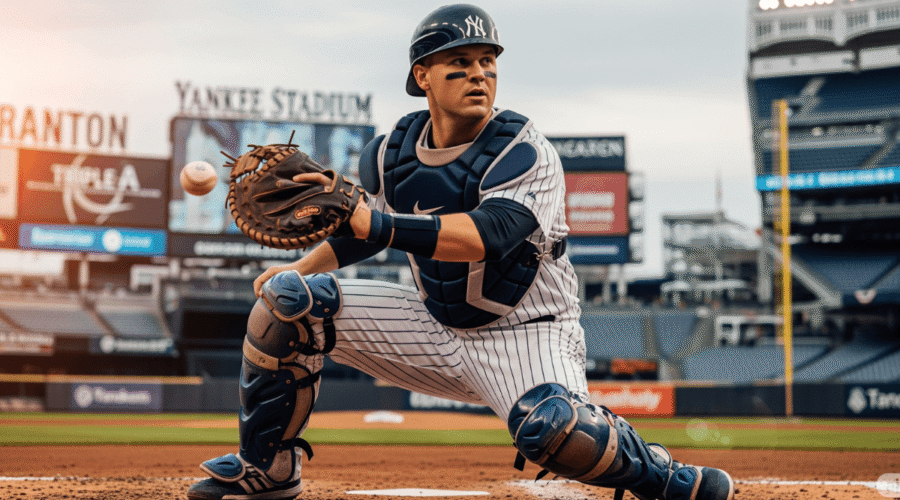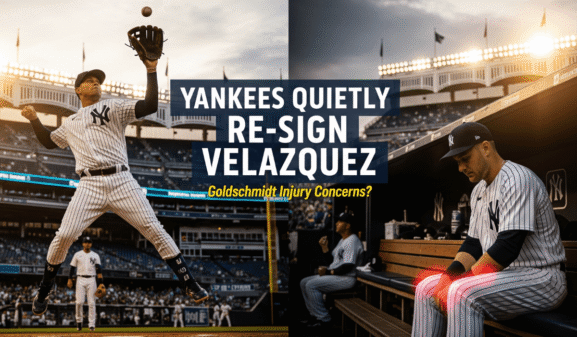Yankees Quietly Bring Back Veteran Catcher Rob Brantly: Filling the Depth Chart
The New York Yankees have made a low-key but potentially significant move, re-signing veteran catcher Rob Brantly to a minor league deal just one week after the Miami Marlins released him (per YES Network’s Conor Foley). The timing tells a story about organizational planning and the ripple effects of their recent trade deadline activity.
Why This Move Makes Perfect Sense Right Now
The Yankees find themselves in an interesting spot behind the plate heading into the stretch run. They’re sitting pretty at the major league level with Austin Wells emerging as their primary backstop, Ben Rice providing versatility, and J.C. Escarra serving as depth. But look deeper into the system, and you’ll see why Brantly’s return was almost inevitable.
During their aggressive trade deadline push, the Yankees dealt away catching prospects Rafael Flores and Jesus Rodriguez as parts of packages to acquire relievers David Bednar from Pittsburgh and Camilo Doval from San Francisco, respectively (per MLB.com’s Bryan Hoch). Those moves improved their bullpen significantly, but they also created a vacuum in their upper-level catching depth that needed addressing.
According to reports, Triple-A Scranton was left with just 24-year-old Omar Martinez as their primary catcher after those deadline deals, with organizational backstop Edinson Duran briefly filling gaps. For a team with playoff aspirations, that’s cutting things awfully thin. One injury at the major league level, and suddenly you’re promoting untested talent or scrambling on the waiver wire.
Brantly represents the exact type of insurance policy smart organizations carry. The 36-year-old Bronx native has been through this rodeo before, having spent 2021-22 in the Yankees system. During that previous stint, he logged seven games at the major league level, going 4-for-23 with a memorable double that broke up Michael Kopech’s perfect game attempt in May 2022. Those aren’t eye-popping offensive numbers, but they demonstrate he can handle big-league pitching when called upon.
Read more: Yankees Quietly Re-Sign Velazquez: Goldschmidt Injury Concerns?
The Brantly Profile: Veteran Reliability
What makes Brantly attractive isn’t his bat, though his recent Triple-A numbers with Jacksonville have been surprisingly solid. Sources indicate he slashed .359/.390/.590 with six doubles and a homer in just 41 plate appearances before Miami cut him loose. Those are small sample size numbers, but they suggest he’s still got something left in the tank.
The real value comes from his experience and defensive reliability. Brantly has appeared in parts of 10 major league seasons, accumulating 472 big-league plate appearances with a career .226/.286/.323 slash line. More importantly, he’s logged over 2,700 Triple-A plate appearances across 13 seasons, meaning he knows how to handle veteran pitchers working their way back from injury and young arms learning their craft.
His familiarity with the Yankees organization removes the typical adjustment period. He knows the coaches, the system’s expectations, and how they want their catchers to handle game-calling responsibilities. That institutional knowledge becomes invaluable when you need someone to step in seamlessly during a pennant race.
The defensive metrics have always been Brantly’s calling card. While he’s never been mistaken for Johnny Bench offensively, teams keep bringing him back because he handles pitching staffs well and provides steady work behind the plate. For a Yankees organization that’s been aggressive about developing young pitching talent, having a veteran catcher who can guide those arms through crucial development phases makes sense.
Reading Between the Lines
Multiple outlets report this as a straightforward depth move, but the timing raises some interesting questions. Why bring back a 36-year-old catcher unless you’re genuinely concerned about your current depth situation? The Yankees don’t typically make moves just to make moves, especially not with players they’ve already evaluated recently.
There’s growing speculation that this signing could indicate the Yankees are more worried about potential injuries than they’re letting on publicly. Wells has been durable this season, but catching is a physically demanding position, and the wear accumulates quickly during a long season. Having Brantly ready at Triple-A means they won’t be caught off-guard if something happens.
Word around baseball is that the Yankees have also been monitoring the waiver wire for additional catching help, though nothing has materialized yet. Brantly’s signing might be their way of addressing that need internally rather than giving up assets or taking on salary obligations.
According to Bryan Hoch’s reporting, team officials view this as smart organizational planning rather than a reaction to immediate concerns. The Yankees have consistently emphasized depth throughout their system, and losing two catching prospects at the deadline created an obvious hole that needed filling.
What This Means for the Roster Picture
Reports indicate that Brantly’s presence at Triple-A gives the Yankees flexibility in how they handle their major league catching situation. If Wells needs a breather or Rice gets moved around the diamond more frequently, they can confidently promote Escarra knowing there’s experienced backup waiting in Scranton.
The financial implications are minimal—minor league deals don’t impact luxury tax calculations, and Brantly represents the cheapest possible insurance policy. For a team that’s been careful about managing payroll while staying competitive, these under-the-radar signings often pay huge dividends when injuries strike.
There’s also the development angle to consider. Sources suggest the Yankees value having veteran catchers at the upper levels to work with their pitching prospects. Brantly’s experience could prove valuable for arms making their way through the system, particularly if any rotation injuries force them to dip deeper into their organizational depth.
The stolen base element shouldn’t be overlooked either—while Brantly isn’t known for his speed, his game-calling experience could be crucial in late-inning situations where opposing runners might test inexperienced catchers.
How Likely Is This to Matter?
Probability: Medium
The Yankees clearly felt urgency to address their catching depth, or they wouldn’t have moved this quickly after the Marlins released Brantly. Teams don’t typically re-sign players they’ve recently evaluated unless there’s genuine organizational need.
If everyone stays healthy, Brantly remains invisible organizational depth—valuable but unused. However, if injuries hit the catching corps, expect him to become relevant quickly. The Yankees won’t hesitate to promote him if circumstances demand it, and his familiarity with the organization means he could contribute immediately.
The development impact could prove significant regardless of major league usage. Having an experienced catcher working with Triple-A pitchers often pays dividends that don’t show up in box scores.
Fan and Industry Reaction
Yankees fans on social media seem generally supportive of the depth move, with many remembering Brantly’s brief but memorable stint during his previous time in the organization. The perfect game breaker moment created some positive memories that make this reunion feel natural.
Industry observers view this as standard organizational maintenance rather than anything dramatic. Multiple sources characterize it as the type of move contending teams make to ensure they’re prepared for various scenarios.
Bottom Line
This looks like smart organizational planning with minimal downside risk. The Yankees identified a depth need created by their trade deadline activity and addressed it efficiently by bringing back a familiar face. While Brantly’s major league impact might be limited, his presence provides insurance and development value that could prove crucial during a pennant race.
The move reinforces the Yankees’ commitment to comprehensive roster building rather than just focusing on star acquisitions. Sometimes the most important signings are the ones nobody talks about until they suddenly become essential.
What do you think—smart depth move or sign the Yankees are more concerned about catching injuries than they’re admitting? Follow along as the stretch run unfolds.
FAQ
Q: Is Rob Brantly officially back with the Yankees?
A: Yes, he signed a minor league contract and was assigned to Triple-A Scranton/Wilkes-Barre.
Q: What would it cost to promote him?
A: Nothing significant—he’s on a minor league deal with no major financial implications.
Q: How likely is he to reach the majors?
A: Low to medium, unless injuries strike the current catching corps or roster moves create opportunities.
Q: When might we see him promoted?
A: Only if injuries occur or the Yankees need experienced depth during September roster expansion.
Q: How does this help the Yankees?
A: Provides experienced catching depth and veteran presence for developing pitchers at Triple-A level.
Q: Where can I follow updates on this situation?
A: Monitor Yankees beat writers and MLB Trade Rumors for any roster movement updates.

